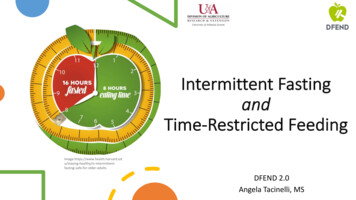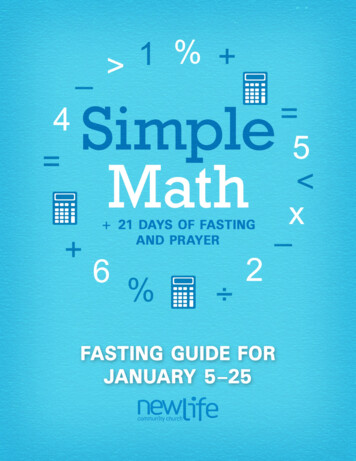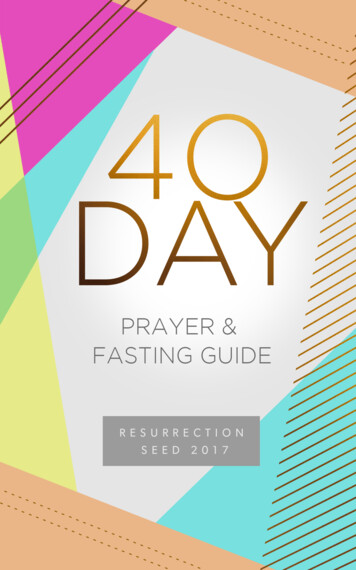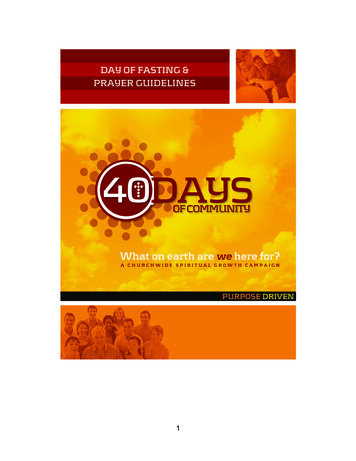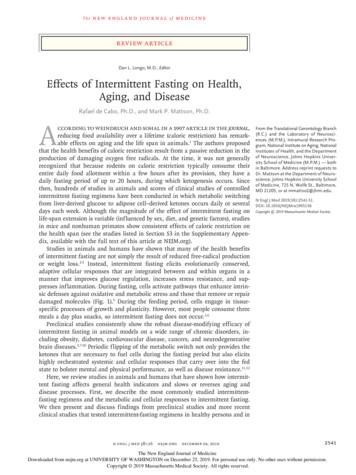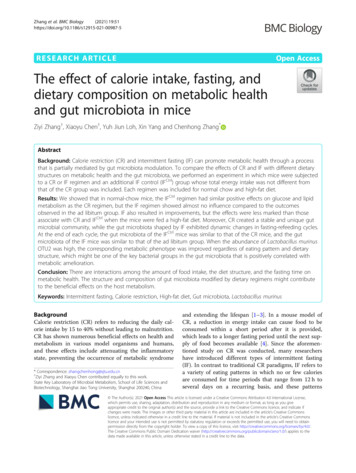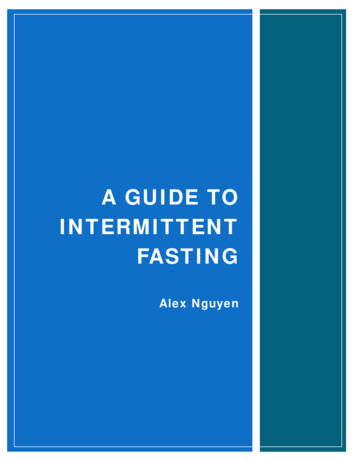
Transcription
Table of ContentsiA GUIDE TOINTERMITTENTFASTINGAlex Nguyen
iNoticeThe information presented in this manual is not intended for treatment or preventionof disease. Please consult your physician before starting any diet or training program.
iiA Guide to Intermittent FastingTable of ContentsTable of Contents . iiIntroduction. vWhat is Intermittent Fasting (IF)? . vWhy should you fast? . vWho is this manual for?. vThe essentials for a successful Intermittent Fasting program . viWhat you don’t need . viAbout fat loss supplements . viChapter 1: Basic Dietary Guidelines . 3How does weight loss occur? . 3Why IF works . 3What if I want to gain weight?. 3Preserving Muscle . 3Your Body is amazing at survival . 4Are all calories equal? . 4All calories are equal, but are all foods equal? .4Macronutrients and Caloric Maintenance . 5Starvation vs. Hunger . 6Chapter 2: Intermittent Fasting Programs. 11The 24 Hour Fast (24 hour fast once a week) . 11Who is this approach for? . 11Rules . 11Instructions . 11What not to do . 11The Leangains fast (16/8 hour fast) . 12Who is the approach for? . 12Rules . 12Instructions . 12What not to do . 13Below is an example of my adaptation of the Leangains program. 13The Warrior Diet (20/4 hour fast) . 14
iiiWho is this approach for? . 14Rules . 14Instructions . 14What not to do . 15Example (warrior diet: dinner) . 15The Alternate Day Fast (36/12 hours fast) . 16Who is this approach for? . 16Rules . 16Instructions . 16Example (alternate day fast) . 16Chapter 3: Intermittent Fasting and You . 19Deciding if intermittent fasting is for you . 19I want to try Intermittent Fasting. 19Designing your own IF program . 19Tips for Success . 20Final Words and Summary . 22
IntroductionvIntroductionWhat is Intermittent Fasting (IF)?The word “Intermittent” is defined as “occurring in irregular intervals”. The wordfasting is an act in which one refrains from a certain activity for a specific period oftime. Simply put Intermittent Fasting is refraining from food for a certain time period.IF has two components A fasting period: time interval in which you refrain from eatingA feeding window: time interval in which you are allowed to eat.What Intermittent Fasting (IF) is not? IF is not a magic bullet for weight loss, you will not lose 10lbs in one week. Youmay however make consistent loss such as 1pound per week.IF does not claim to be the best diet or the best approach to dieting foreveryone. IF is a simplified diet method that works best for the busy individual.IF is not a necessity. IF, like every other diet is just a tool to help you loseweight. Think of it as another tool to add to your toolbox for fat-loss. There areplenty of other ways to lose weight.Why should you fast?Intermittent fasting has many benefits, here are a few. Lower blood pressureLower oxidative stressIncreased fat burningIncreased metabolic rate during the fastImproved appetite controlImproved blood sugar controlImproved cardiovascular functionWho is this manual for?This manual is for those who Want to learn the basic of intermittent fastingWant a to improve their healthExperience a consistent and manageable way to lose weight.Want to adhere to a diet and without the hassle of being limited to certainfoods.This manual assumes that you have an exercise program to accompany an IFdiet program. Maximum fat loss cannot be achieved through diet alone instead
viA Guide to Intermittent Fastingit is a combination of exercise and diet that produces maximum fat loss. If youdo not have an exercise program do not fright. An exercise program can be assimply as jogging for 30minutes a day. However it should be noted that a welldesigned training program that is tailored towards your goal will produce thebest results.The essentials for a successful Intermittent Fasting program DedicationDeterminationYour bodyA good exercise programWhat you don’t need You will not need to buy specific foods, eat what you want to but remembermoderation is the key factor.You will not need a personal trainer if you are well-versed in training. If you arenot you may seek out a trainer or consult the internet for information.You don’t need any shady fatburning supplements.About fat loss supplementsThey don’t work. Yep, fat losssupplements are a huge waste of money.They don’t speed up your metabolism oranything. In fact most of them justsuppress your appetite so you eat less.Appetite suppression is something youcan control with sheer will power so whypay money for it?
Chapter 1Basic Dietary GuidelinesBasic dietary knowledge
Chapter 13Chapter 1: Basic Dietary GuidelinesThe following information can be applied to any diet. Before you start any diet it isimportant that you familiarize yourself with the basics of a diet.How does weight loss occur?Weight loss is a process of being in a caloric deficit. A caloric deficit is when you usemore calories than you are consuming. Weight loss cannot occur without a caloricdeficit. Go back and read the last sentence untilyou have fully grasped the concept of weight loss.What if I want to gain weight?Since weight loss occurs when we are notconsuming enough calories to meet our daily use,then weight gain is the opposite. Weight gain occurswhen we exceed our daily caloric needs thus theextra calories are stored as fat. If you induce astimulus such as weight training than the extracalories will be used to repair and improve thedamaged muscles thus enlarging your muscles andultimately results in you gaining muscle weight.Preserving MuscleWhy IF worksAs you know by now losingweight is all about being in anegative calorie deficit. In atypical IF program you will fastfor the majority of the day. Thenyou may have one meal at theend of the day.So even if you attempt to overeatduring that one meal you will befull way before you reach yourdaily caloric intake. Thus youwill be in a constant negativedeficit.You always hear people saying “I want to loseweight” or “I need to lose some weight” but theynever specify what type of weight. Musclecontributes to your total bodyweight too, so doeswater, and your organs and so on. You could lose10lbs of muscle, but would you be satisfied? The correct phrase is “I want to lose fat”.Typically fat (adipose tissue) is what most people are referring to when they want tolose weight. However what inevitable happens during a diet is muscle loss. Here’s why.Muscles are calorically expensive. Think of it as a bank. Say each pound of leanmuscle requires 25 calories to uphold. So if 100lbs of your total bodyweight is puremuscle than you need to eat 2,500 calories a day just to maintain your muscle mass.Say now you want to go on a diet so you reduce your calories down 2,300. Now aproblem arises. You don’t have enough calories to maintain your muscle mass. Stillusing the bank analogy, you are now presented with two choices you can sell off yourmuscle (break down muscle tissue to pay for the other muscles and reduce totalspending) or you can take out a loan (break down fatty tissue for extra calories).
4A Guide to Intermittent FastingIdeally you want the latter because that’s what fat is for right? Fat is to be used asenergy when we are in a deficit.So then how does muscle loss occur? Muscle loss occurs when we exceed our loanlimit. Say our deficit is now 1500 calories and we still need 2500 calories each day. Wefind ourselves down 1000 calories however we can only take out a max loan of 500calories from our fat reserves. This limit occurs because there is a limit to which fatcan be broken down. Thus we are force tobreakdown some of our muscle to pay for therest. So in conclusion to minimize muscleYour Body is amazing at survivallosses always reduce your daily calorie needsBack during the ice age era ourby small increments (200 or 100 calories) soancestors would go days withoutthat you don’t exceed your loan limit. Utilizeeating. They lived their life nota strength training program to ensure thatknowing when their next meal wouldyour body realizes that your muscles arebe or what it will come from.needed.So our body is well-adapted forAre all calories equal?survival. This is why our body storesYes are calories are equal. There is no suchfat, to have an extra storage ofthing as good food and bad food just foodcalories when we are starving. Fat isthat are more calorie dense (higher inour insurance. Another reason whycalories) and food that are lower in calories. Ifour body prefers breakdown ouryou still have doubts about a calorie being amuscle is that it sees that it cancalorie, go read about the professor who lostreduce daily spending by getting rid of27 pounds while eating only Twinkies.the calorie expensive things such asmuscle.All calories are equal, but are all foodsequal?I said earlier that there aren’t such things asgood foods or bad foods well that was a lie.There are foods that are filled to the brimwith man-made chemicals such as highfructose corn syrup. These chemicals arepotentially harmful and thus should beavoided or kept to a minimum. As a generalrule the closer the food is to its natural form,the better. I am not saying that you can’tenjoy your favorite foods but simply statingthat the majority of your diet should consistof natural foods. The benefits of a healthydiet are endless but here are a few Higher energy levelsBetter moodHowever our ancestor didn’t have toworry about losing muscle becausetheir lifestyle was more active. Theyhad to run, jump, climb trees, scalemountains, throw spears, carry theold and wounded, and so on. So theirbody’s top priority was to keep theirmuscle or else they wouldn’t survivein such a world.Fast forward to today and a majorityof us lead sedentary lifestyles. Ourbody says “oh it’s okay for us to getrid of these muscles, it’s not like weuse it for anything”. That’s whereweight training comes in. Weighttraining gives our body a reason tokeep our hard-earned muscles.Remember our body adapts to makelife easier not harder.
Chapter 1 5Less risk of diseasesStronger immune systemHealthier skinStronger bonesLonger lifeMacronutrients and Caloric MaintenanceI won’t delve too much into this topic as there is a wealth of information on theinternet and it would be outside the scope of this manual. So consider this a briefintroduction to macronutrients.Macronutrients are protein, carbohydrates, and lipids (fats).Protein: If you are a serious weight lifter or an athlete then you should be aware of theimportance of protein. Proteins are the building block of muscle and any aid inrecovery after a training session. Of the three (carbs, fats, and protein) protein is themost important. Protein can be found in meats, dairy, nuts, and legumes (beans). Thegeneral rule for any athlete is 1 gram of protein per pound of bodyweight. For exampleif you weigh 150lbs than you should strive to eat 150 grams of protein per day. Eachgram of protein is equivalent to approximately 4 caloriesCarbohydrates: Carbohydrates are your body’s main source of energy. The majority ofyour daily calories will come in the form of carbohydrates. Carbohydrates come in twomajor forms, sugars and starches. Sugars are easily digested and thus enter the bloodstream immediately. Starches take a while to digest and are often stored in themuscles as glycogen. Each gram of carbohydrate is equivalent to approximately 4calories. Examples of carbohydrates are bread, pasta, grain, sugar, potatoes, and rice.Fats: The media has completely destroyed the reputation of fats and thus when wehear the word we often associate it with synonyms such as “bad”. However fats are notall bad and some fat is necessary for optimal health. There are three types of fats,saturated, unsaturated and trans. Generally trans-fat are bad and increase your riskof heart disease. Saturated fats are not necessary bad but should be limited to a smallpercent of your diet. Foods with saturated fats are meat, butter, lard, cream, etc.Unsaturated fats have been proven to decrease your risk of developing heart disease.You can include unsaturated fats into your diet by consuming foods such asavocados, nuts and any food cooked with olive oil.Caloric Maintenance: caloric maintenance is simply the number of calories your bodyneeds in day to maintain homeostasis, which is to have no weight gain or weight lossbut to stay at equilibrium. Caloric maintenance varies with each individual. It may behigher if you are younger, more active, and have more muscle mass. Your caloricmaintenance will be achieved through a combination of protein, carbohydrates andfats. Generally for new trainees I recommend a standard 40/40/20 ratio which means40% protein, 40% carbohydrates and 20% fats. For example I generally eat around
6A Guide to Intermittent Fasting3000 calories a day to maintain my bodyweight. So 40% of 3000 is 1200 calories.1200 divided by 4 is 300 grams of protein. If I followed a 40/40/20 ratio then my dietwould be the following3000 caloriesProtein 40%Carbohydrates 40% Fats 20%(40/40/20)calories12001200600grams300g300g67gIt should be noted that consuming 300grams of protein in one day is next toimpossible as that would mean you would have to chug down copious amounts ofprotein shakes. Thus a more realistic macronutrient ratio would be a 20/60/20 ratio.See below for an example.3000calories(20/60/20)caloriesgramsProtein 20%Carbohydrates 60%Fats 20%600150g1800450g60067gTo determine your caloric maintenance a good starting point would be to use a dailycalorie calculator. You can find many calorie calculators online such as the oneat Freedieting.com. My suggestion is to use the calculator to obtain an estimate. Thentest the estimate for two weeks if you happen to gain weight subtract a little, such as200 calories from the estimate and retest for another two weeks. If you lose weightthan try adding 200 calories to the estimate and keep testing until you find yourcaloric maintenance. I know this task is meticulous and often frustrating when youhave to carry a calorie log everywhere you go. Even then there will be times when youwill not be able to know how much calories is in the meal you consumed.However the good news is that with enough experience you will eventually be able toaccurately guess how much calorie certain foods consume. For example I am now ableto eye-ball foods and obtain a good estimate of how much calorie was in the meal I ate.Starvation vs. HungerA common mistake to make during a diet is to confuse hunger with starvation. Peoplewill often feel their stomach growling and assume that if they don’t eat soon they willvaporize into thin air. Well I was kidding about the vaporizing, but people will oftenpre-maturely end their fast because their stomach was rumbling. The premise is thatonce your body enters starvation mode your metabolism rate drops thus you will burnless calories and your diet will be in vain. However that is not the case. Studies onfasting and metabolism has shown that the earliest sign of a decrease in metabolismoccurs after 60 hours and none of the IF programs will have you fasting more than 24hours so you won’t have to worry about a reduced metabolism.So what do I do about the hunger pangs? From personal experience I found that if youjust ignore them and continue about your day the hunger will go away immediately.
Chapter 17However do not mistake hunger with physical pain. If your stomach is in physical painand actually hurts then you are doing something wrong. Please consult a physician.The good news is that if you follow the IF methods that I have listed in chapter 2 youwill never have physical stomach pain.An interesting phenomenon that I learn about hunger is that you are able to controlhunger. Before I started using intermittent fasting I use to eat 6 meals a day. Youknow the whole “if you eat more you will increase your metabolism nonsense” whichhas been proven wrong in case you were wondering. During my six meals a day diet Inormally ate at 8:00am. 11:00am, 2:00pm, 5:00pm, 8:00pm and 11:00pm. So duringthe first week of intermittent fasting I would become hungry around the same timesbecause my body was so used to eating at those times. However I ignored my hungerand by my third week of IF my tolerance for hunger was slowly dissipating and I couldgo longer without eating. Not only that but I would only feel hungry during the feedingwindow of my intermittent fasting program. So what’s the moral of the story? You arein the master of your hunger.
Chapter 2Intermittent Fasting ProgramsAn introduction to the most popular intermittent fasting programs
Chapter 211Chapter 2: Intermittent Fasting ProgramsThe 24 Hour Fast (24 hour fast once a week)Popularized by Brad Pilon author of Eat Stop Eat, the 24 hour fast is a fast that lastsan entire day. You will only fast on one day of the week and on the other 6 days youwill eat normally. The 24 hour fast views fat lossin a weekly basis. For example if you normallyeat 2000 calories per day that is a total of14,000 calories a week. Now if you subtract oneday then you are down to 12,000 calories. If youwant to know more about this approach and thescience behind it check out Eat Stop Eat.Who is this approach for?Brad PilonThe 24 hour fast works great for beginners and casual dieters.It is the easiest of all the programs because there is only one rule to follow. People whoare new to IF should start with the 24 fast and work their way to the other IFprograms if desired.Rules1. Don’t eat for 24 hoursInstructions1. Pick a day you would like to fast on2. Set the beginning time for your fast for example if you decide that your lastmeal should be at 8:00pm on Wednesday than you will fast until 8:00pm onThursday3. Be productive on your fast day and get your work done.What not to do Don’t compensate by eating more on the other 6 days. If you do find yourselfeating more, know that you have some space for cushion. For example if youate an extra 400 calories on Friday know that you are still in a deficit of 1600(2000-400) so do not worry.Don’t think about food during your fast. Keep your mind occupied.
12A Guide to Intermittent FastingThe Leangains fast (16/8 hour fast)This approach was created by personal trainer Mark Berkhan and is popular amongweight-lifters. The approach includes a 16 hour fastaccompany with an 8 hour feeding window. The 8 houreating window should be the same every day. Meal frequencyis not important as long as you eat during the 8 hours. TheLeangains fast is done daily as opposed to once a week. Thisapproach is highly specific and was design for weigh-liftersthus it is recommended for athletes.Who is the approach for?The LeanGains fast is for athletes and any serious weightlifter. It is not recommended for casual exercisers orbeginners due to its complex planning.Mark BerkhanRules1. Diet should be high in protein2. You should include fasted training (training while fasted)3. You should cycle carbohydrates (training days should be high in carbohydrateswhile off-days are lower in carbohydrates).4. Feeding windows need to be consistent.5. On training days your post workout meal should be your largest meal.6. On non-training days your first meal should be your largest meal.7. Be sure to take some BCAA (branch chain amino acids) before you train toensure that you do not experience muscle loss during your fasted training.Instructions1. Determine your 16 hour fast period. Ideally you would want the fast to extendover night as you sleep. If you place your 16 hour fast during the time that youare awake then it would mean that your 8 hour feeding window occurs duringthe time you sleep. For example if your last meal is at 6:00pm on Tuesday thanyou would fast until 10:00am on Wednesday. Your feeding window would befrom 10:00am to 6:00pm.2. Once you decided on a fasting period your feeding window will be the remaining8 hours of the day3. Determine a time for training. Ideally you would want your training period to bejust before you feeding window such that your first meal of the day will also beyour post-training meal.
Chapter 213What not to do Do not schedule your fasting period such that your feeding window will be thesame time as the time you normally sleep.Do not forget to take your BCAAs before you proceed with fasted-training. Mostprotein supplements contain BCAAs.Below is an example of my adaptation of the Leangains program. Note that my training sessions are also part of the fast.Notice how I adapt my schedule on the weekend due to limitations such ascafeteria FastedperiodFastedperiodFastedperiodFastedperiod
14A Guide to Intermittent FastingThe Warrior Diet (20/4 hour fast)The warrior diet is a 20 hour fast period followed bya 4 hour feeding window. Like Leangains, TheWarrior diet is daily too. The warrior diet was createdby Ori Hofmekler and is inspired by nutritionalhabits of Greek warriors and Spartans. With thisplan you would either fast or eat miniscule amountsof food for 18-20 hours. Then you would consume amajority of your daily caloric intake in the remaining4-6 hours. Ideally you should place your feedingwindow near the end of the day as it is moreconvenient for family dinners and after-work training sessions. The onlyOri Hofmeklerproblem with The Warrior Diet is that trying to fit your daily caloric intakein one meal can be difficult. In summary The Warrior diet is primarily a 20 hour fastfollowed by one large meal. For more information check out Ori’s book The WarriorDiet.Who is this approach for?The warrior diet is for people who are looking for an entry point into fasting. This dietis very flexible and not as strict as Leangains. This diet is a favorite for people who loveto splurge in calorie dense food (i.e. pizza, hamburgers, cakes, etc.)The warrior diet isa great introductory diet to fasting. It makes transitioning to a traditional fast easieras it allows you to have small snacks during the day given that your snacks have toconsist of fruit and vegetables. If you are looking to try out fasting or get an idea ofwhat fasting is about start with The Warrior Diet.Rules1. Fast for at least 18-20 hours.2. Snacks are confined to vegetable and fruits, occasionally a protein shake3. Keep your diet high in protein (remember at least 1 gram per pound ofbodyweight)4. Try to meet your daily calorie needs in one meal, meaning you can indulge incalorie dense food to reach you goal. Well technically speaking it isn’t one mealsince you have 4 hours to eat what you want to, but let’s be honest how manypeople are still hungry after the first meal?Instructions1. Determine what meal you want to place you feeding window around (i.e.breakfast, lunch, dinner)2. Determine how large you want you feeding window to be 4-6 hours is the minand max. Your fasting period will be the remaining hours in the day.
Chapter 2153. Decide if you want to eat snacks or do a complete fast during the day.Remember your snacks have to be either fruits or vegetables and maybe aprotein shake.What not to do1. Do not eat anything calorie dense for snacks such as chips, sweets, pastries.Only fruits and vegetables are allowed (baby carrots, spinach wraps, grapes,apples, etc).2. Do not have any large meals outside of you feeding window3. Do not constantly switch up your one large meal (i.e. going from dinner on oneday to breakfast of the next day) keep it consistent.Example (warrior diet: dinner)7:00am to 5:00pm (assumes 7:00am isthe start of the day)MonFasted period6:00pm to 10:pmFeeding Window (mainly Dinner)11:pm to 6:00Fasted Period/Sleep
16A Guide to Intermittent FastingThe Alternate Day Fast (36/12 hours fast)On this program you eat every other day. Basically you eat in a 12 hour window, say7:00am to 7:00pm on Monday. Then you fast for the remainder of Monday and allthroughout Tuesday. On Wednesday you eat again from 7:00am to 7:00pm. Rinse andrepeat. During your feeding window you may eatanything you desire however it is recommended that youdiet mainly consist of nutritional food. The alternate fastdiet was popularized by Dr. James B. Johnson, pleasesupport him and buy his book, The Alternate Day Diet, ifyou wish to know more.Who is this approach for?The alternate day diet is suited for the general public i.e.the casual dieter. It is easy to pick up and apply. I wouldrecommend this IF program for beginners as it isn’t too strictand it does not have to be used in conjunction with atraining program.Dr. James B. JohnsonRules1. Fast for 36 hours.2. Eat normally during the 12 hour feeding window3. You may eat anything you like, calorie dense food in moderation of course(unless you are severely behind on your calories and need a boost).Instructions1. Determine the time for your 12 hour feeding window. Note most people choosethe start time as the time when they first get out of bed.2. Your fasted period will be the remaining 12 hours of that day plus the next day.You will eat the day after your fasted day.Example (alternate day fast)8:00amto8:00pmThe restof wFastedPeriod
Chapter 3Intermittent Fasting and YouHow to incorporate intermittent fasting in your life and a few tips tomake it work
Chapter 319Chapter 3: Intermittent Fasting and YouDeciding if intermittent fasting is for youIntermittent fasting isn’t for everyone. Some people lose weight
Popularized by Brad Pilon author of Eat Stop Eat, the 24 hour fast is a fast that lasts an entire day. You will only fast on one day of the week and on the other 6 days you will eat normally. The 24 hour fast views fat loss in a weekly basis. For example if you normally eat 2000 calories per day that is a total of 14,000 calories a week. Now if .
